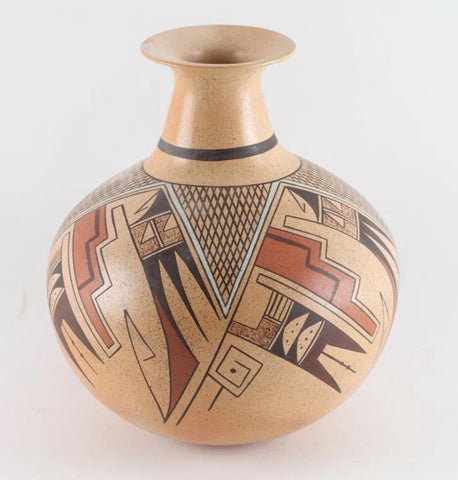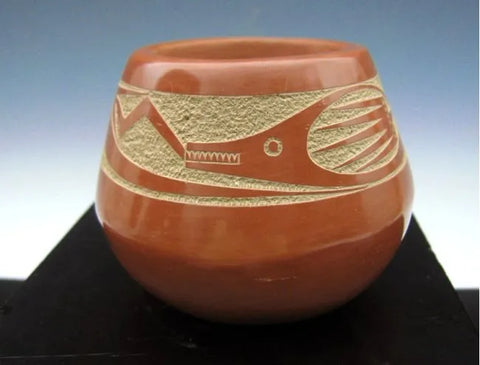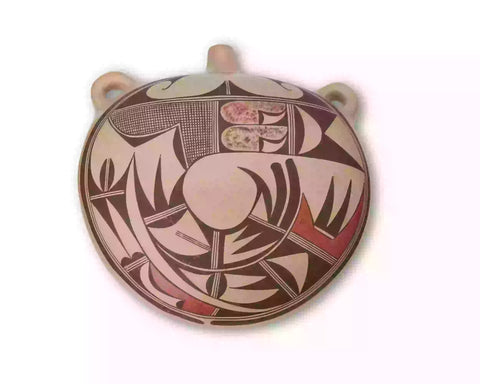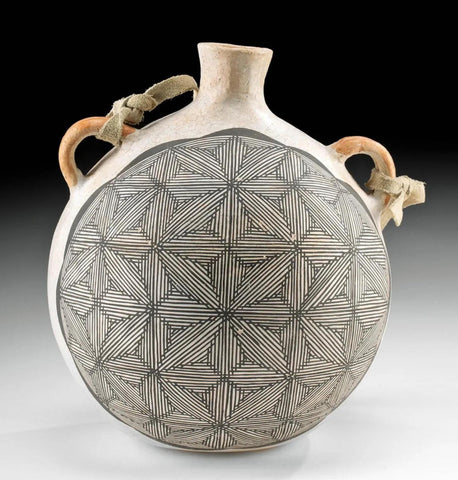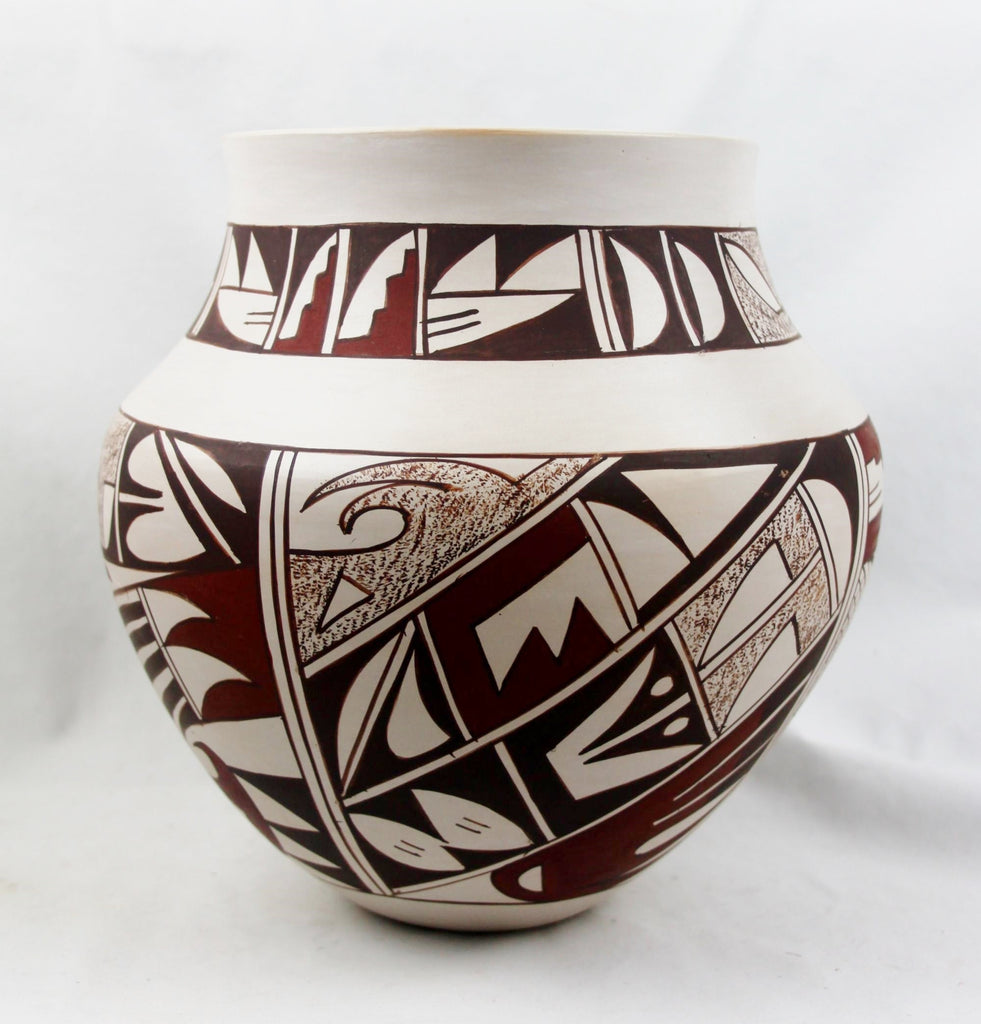
Native American Vintage Hopi Poly Chrome Pottery Jar, by Joy Navasie, Frog Women (1919-2012), Ca 1980's, #1494 Sold
$ 3,675.00
Native American Vintage Hopi Poly Chrome Pottery Jar, by Joy Navasie, Frog Women (1919-2012), Ca 1980's, #1494
Description: #1494 Native American Vintage Hopi Poly Chrome Pottery Jar, by Joy Navasie, Frog Women (1919-2012), Ca 1980's. Very fine, poly chrome-on-white Hopi pottery jar with classic, avian inspired, traditional motif. Ca. 1980's.
Condition: Very good condition. Includes picture of Joy holding this jar.
Dimensions: 9" x 9"
Joy Navasie (1919, Hopi-Tewa - 2012) (also known as second Frog Woman or Yellow Flower) is a Pueblo potter. As well as the art of pottery, the name Frog Woman was passed down from her mother, Paqua Naha.[1][2]
Navasie carries on the white ware pottery tradition from her mother, which she contends was developed around 1951 or 1952. She is particularly known for her black and red on white designs, and her favorite motifs include rain, clouds, parrots, and feathers. Her pots are signed with a frog—a hallmark she began around 1939. Her signature differs from her mother's in that it features web feet rather than short toes.[1]
All Navasie's pottery is made the traditional way, from the gathering of the clay to the polishing and painting. Pots are fired in sheep dung, which she says is getting more difficult to acquire, but she prefers this over commercial products.[3]
Navasie's pots can be found in a number of museums (Museum of Northern Arizona, Heard Museum, and Spurlock Museum). Wikipedia)
“Pueblo pottery is made using a coiled technique that came into northern Arizona and New Mexico from the south, some 1500 years ago. In the four-corners region of the US, nineteen pueblos and villages have historically produced pottery. Although each of these pueblos use similar traditional methods of coiling, shaping, finishing and firing, the pottery from each is distinctive. Various clay's gathered from each pueblo’s local sources produce pottery colors that range from buff to earthy yellows, oranges, and reds, as well as black. Fired pots are sometimes left plain and other times decorated—most frequently with paint and occasionally with applique. Painted designs vary from pueblo to pueblo, yet share an ancient iconography based on abstract representations of clouds, rain, feathers, birds, plants, animals and other natural world features.
Tempering materials and paints, also from natural sources, contribute further to the distinctiveness of each pueblo’s pottery. Some paints are derived from plants, others from minerals. Before firing, potters in some pueblos apply a light colored slip to their pottery, which creates a bright background for painted designs or simply a lighter color plain ware vessel. Designs are painted on before firing, traditionally with a brush fashioned from yucca fiber.
Different combinations of paint color, clay color, and slips are characteristic of different pueblos. Among them are black on cream, black on buff, black on red, dark brown and dark red on white (as found in Zuni pottery), matte red on red, and poly chrome—a number of natural colors on one vessel (most typically associated with Hopi). Pueblo potters also produce un-decorated polished black ware, black on black ware, and carved red and carved black wares.
Making pueblo pottery is a time-consuming effort that includes gathering and preparing the clay, building and shaping the coiled pot, gathering plants to make the colored dyes, constructing yucca brushes, and, often, making a clay slip. While some Pueblo artists fire in kilns, most still fire in the traditional way in an outside fire pit, covering their vessels with large potsherds and dried sheep dung. Pottery is left to bake for many hours, producing a high-fired result.
Today, Pueblo potters continue to honor this centuries-old tradition of hand-coiled pottery production, yet value the need for contemporary artistic expression as well. They continue to improve their style, methods and designs, often combining traditional and contemporary techniques to create striking new works of art.” (Source: Museum of Northern Arizona)
Description: #1494 Native American Vintage Hopi Poly Chrome Pottery Jar, by Joy Navasie, Frog Women (1919-2012), Ca 1980's. Very fine, poly chrome-on-white Hopi pottery jar with classic, avian inspired, traditional motif. Ca. 1980's.
Condition: Very good condition. Includes picture of Joy holding this jar.
Dimensions: 9" x 9"
Joy Navasie (1919, Hopi-Tewa - 2012) (also known as second Frog Woman or Yellow Flower) is a Pueblo potter. As well as the art of pottery, the name Frog Woman was passed down from her mother, Paqua Naha.[1][2]
Navasie carries on the white ware pottery tradition from her mother, which she contends was developed around 1951 or 1952. She is particularly known for her black and red on white designs, and her favorite motifs include rain, clouds, parrots, and feathers. Her pots are signed with a frog—a hallmark she began around 1939. Her signature differs from her mother's in that it features web feet rather than short toes.[1]
All Navasie's pottery is made the traditional way, from the gathering of the clay to the polishing and painting. Pots are fired in sheep dung, which she says is getting more difficult to acquire, but she prefers this over commercial products.[3]
Navasie's pots can be found in a number of museums (Museum of Northern Arizona, Heard Museum, and Spurlock Museum). Wikipedia)
“Pueblo pottery is made using a coiled technique that came into northern Arizona and New Mexico from the south, some 1500 years ago. In the four-corners region of the US, nineteen pueblos and villages have historically produced pottery. Although each of these pueblos use similar traditional methods of coiling, shaping, finishing and firing, the pottery from each is distinctive. Various clay's gathered from each pueblo’s local sources produce pottery colors that range from buff to earthy yellows, oranges, and reds, as well as black. Fired pots are sometimes left plain and other times decorated—most frequently with paint and occasionally with applique. Painted designs vary from pueblo to pueblo, yet share an ancient iconography based on abstract representations of clouds, rain, feathers, birds, plants, animals and other natural world features.
Tempering materials and paints, also from natural sources, contribute further to the distinctiveness of each pueblo’s pottery. Some paints are derived from plants, others from minerals. Before firing, potters in some pueblos apply a light colored slip to their pottery, which creates a bright background for painted designs or simply a lighter color plain ware vessel. Designs are painted on before firing, traditionally with a brush fashioned from yucca fiber.
Different combinations of paint color, clay color, and slips are characteristic of different pueblos. Among them are black on cream, black on buff, black on red, dark brown and dark red on white (as found in Zuni pottery), matte red on red, and poly chrome—a number of natural colors on one vessel (most typically associated with Hopi). Pueblo potters also produce un-decorated polished black ware, black on black ware, and carved red and carved black wares.
Making pueblo pottery is a time-consuming effort that includes gathering and preparing the clay, building and shaping the coiled pot, gathering plants to make the colored dyes, constructing yucca brushes, and, often, making a clay slip. While some Pueblo artists fire in kilns, most still fire in the traditional way in an outside fire pit, covering their vessels with large potsherds and dried sheep dung. Pottery is left to bake for many hours, producing a high-fired result.
Today, Pueblo potters continue to honor this centuries-old tradition of hand-coiled pottery production, yet value the need for contemporary artistic expression as well. They continue to improve their style, methods and designs, often combining traditional and contemporary techniques to create striking new works of art.” (Source: Museum of Northern Arizona)
Related Products
Sold out
Sold out








